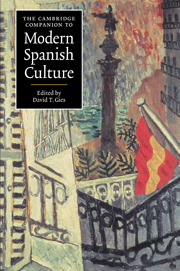Book contents
- Frontmatter
- Modern Spanish culture
- I Culture
- II Culture and history
- 5 History, politics, and culture, 1875-1936
- 6 History, politics, and culture, 1936-1975
- 7 History, politics, and culture, 1975-1996
- III Culture and prose
- IV Culture and poetry
- V Culture and theater
- VI Culture and the arts
- VII Media
- Index
- Series List
6 - History, politics, and culture, 1936-1975
from II - Culture and history
Published online by Cambridge University Press: 28 May 2006
- Frontmatter
- Modern Spanish culture
- I Culture
- II Culture and history
- 5 History, politics, and culture, 1875-1936
- 6 History, politics, and culture, 1936-1975
- 7 History, politics, and culture, 1975-1996
- III Culture and prose
- IV Culture and poetry
- V Culture and theater
- VI Culture and the arts
- VII Media
- Index
- Series List
Summary
The Spanish Civil War of 1936-1939 was fought along the multiple lines of cleavage - of class, ideology, and region - that had been opened by the processes of economic, social, and political modernization over the previous century. Yet despite its complex origins and internal dynamics, participants, commentators, and historians, then and since, have tended to reduce the war to a set of simple oppositions: democracy vs. fascism, Christian civilization vs. godless Communism, the working class vs. the rich, the center vs. the periphery, and so on. This dichotomizing tendency was perhaps inevitable in a war in which propaganda played such an important role, but it was also a consequence of a growing habit of mind among educated Spaniards to conceptualize their society in terms of the “two Spains.” Since the early nineteenth century Spaniards had disagreed - often violently - over the desirability and direction of political and social change.
- Type
- Chapter
- Information
- The Cambridge Companion to Modern Spanish Culture , pp. 86 - 103Publisher: Cambridge University PressPrint publication year: 1999
- 4
- Cited by

